PSYCHOLOGY: Report on Gender Differences and Social Phobia
VerifiedAdded on 2021/04/17
|6
|1174
|64
Report
AI Summary
This psychology report investigates gender differences in cognitive abilities, specifically focusing on socialized phobia and the identification of positive and negative facial expressions. The report examines existing research, highlighting that while there are often no major performance differences between men and women in verbal working memory tasks, there are notable differences in brain activation patterns. The report delves into the prevalence of social phobia, noting its higher occurrence in women, and explores how sex roles and socialization can be contributing factors. Furthermore, the report analyzes studies on emotional recognition, indicating that women may be more adept at recognizing positive facial expressions and threat-related stimuli. The author references multiple studies and provides an overview of the key findings, concluding that more concrete evidence is needed to fully understand the complexities of these gender differences.
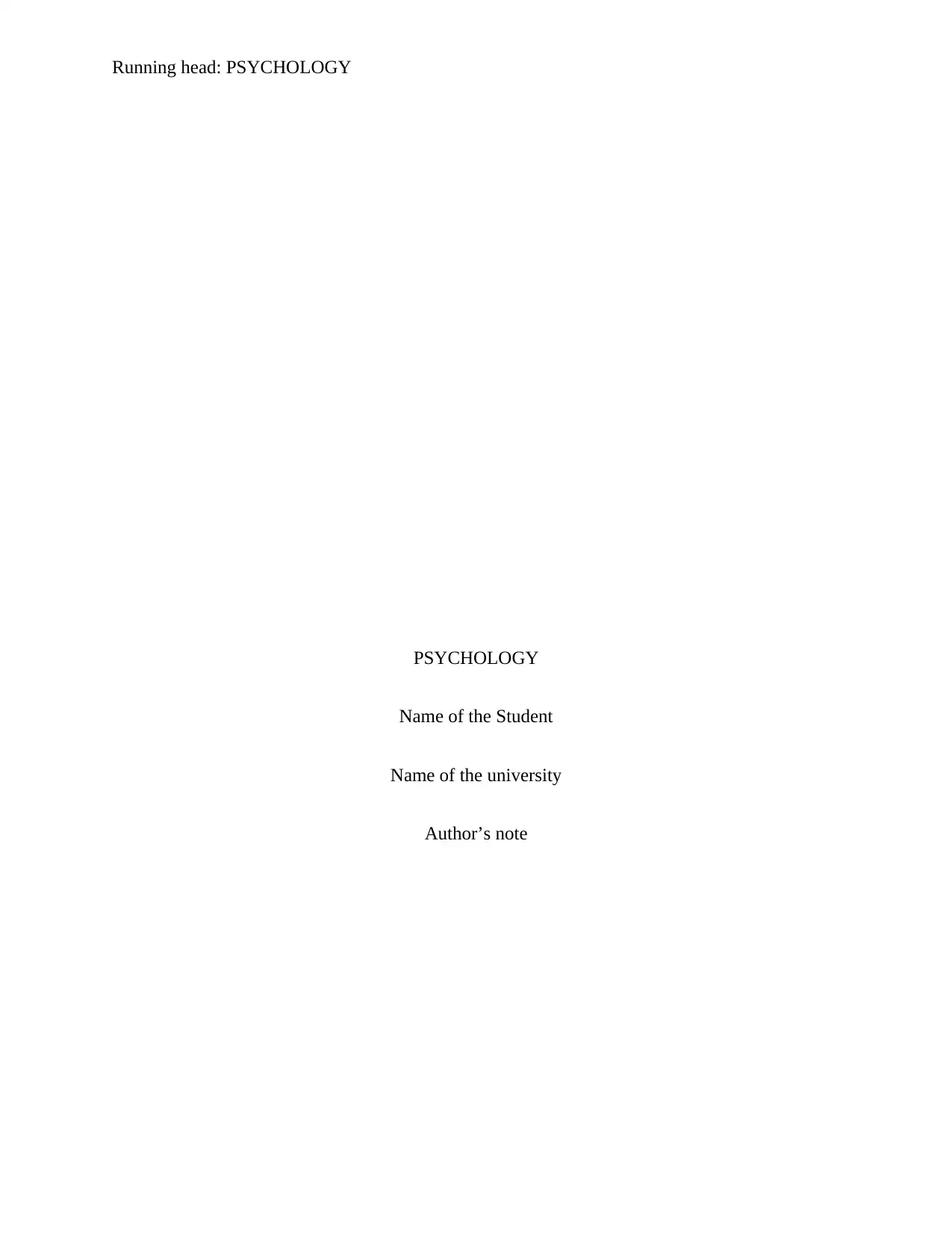
Running head: PSYCHOLOGY
PSYCHOLOGY
Name of the Student
Name of the university
Author’s note
PSYCHOLOGY
Name of the Student
Name of the university
Author’s note
Paraphrase This Document
Need a fresh take? Get an instant paraphrase of this document with our AI Paraphraser
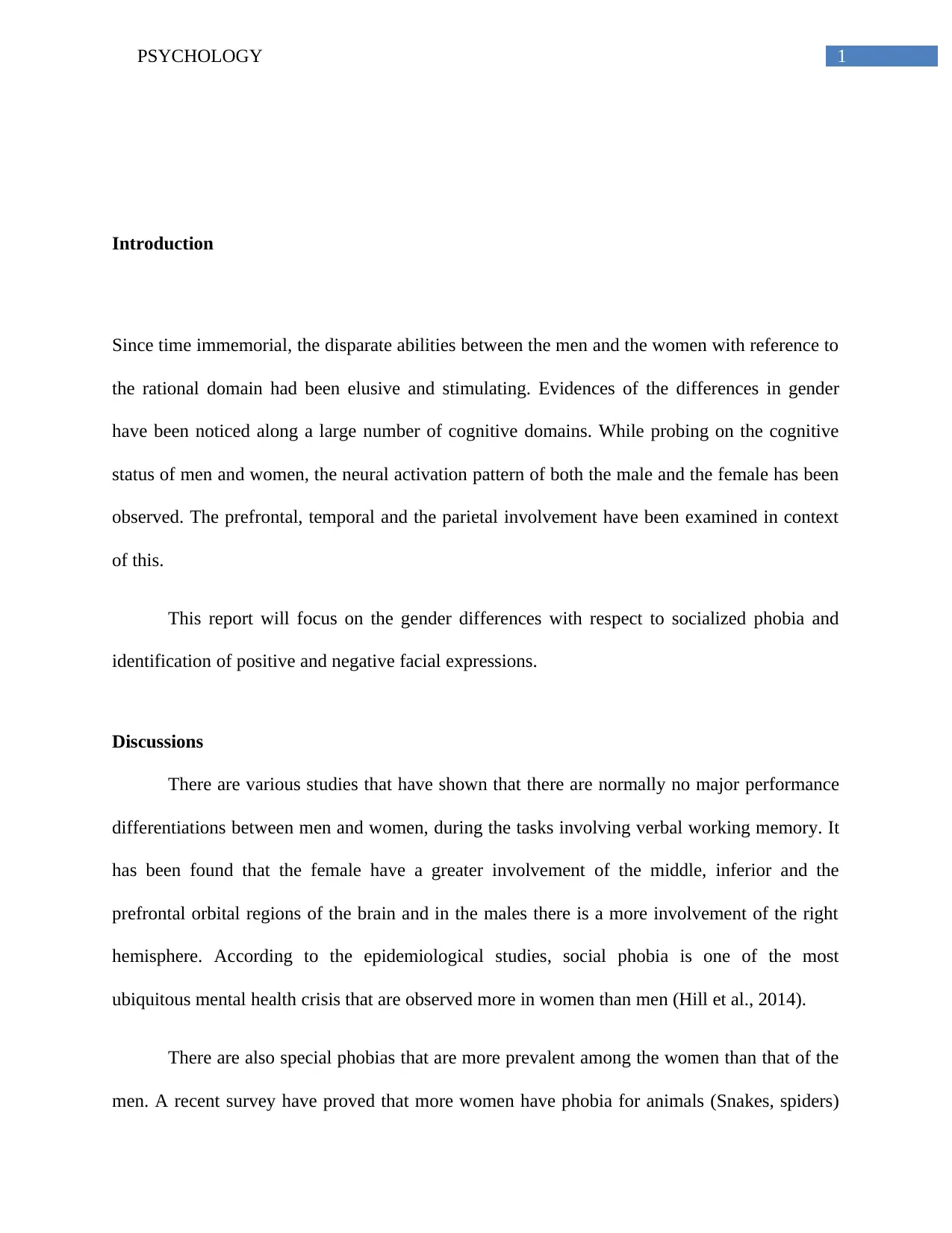
1PSYCHOLOGY
Introduction
Since time immemorial, the disparate abilities between the men and the women with reference to
the rational domain had been elusive and stimulating. Evidences of the differences in gender
have been noticed along a large number of cognitive domains. While probing on the cognitive
status of men and women, the neural activation pattern of both the male and the female has been
observed. The prefrontal, temporal and the parietal involvement have been examined in context
of this.
This report will focus on the gender differences with respect to socialized phobia and
identification of positive and negative facial expressions.
Discussions
There are various studies that have shown that there are normally no major performance
differentiations between men and women, during the tasks involving verbal working memory. It
has been found that the female have a greater involvement of the middle, inferior and the
prefrontal orbital regions of the brain and in the males there is a more involvement of the right
hemisphere. According to the epidemiological studies, social phobia is one of the most
ubiquitous mental health crisis that are observed more in women than men (Hill et al., 2014).
There are also special phobias that are more prevalent among the women than that of the
men. A recent survey have proved that more women have phobia for animals (Snakes, spiders)
Introduction
Since time immemorial, the disparate abilities between the men and the women with reference to
the rational domain had been elusive and stimulating. Evidences of the differences in gender
have been noticed along a large number of cognitive domains. While probing on the cognitive
status of men and women, the neural activation pattern of both the male and the female has been
observed. The prefrontal, temporal and the parietal involvement have been examined in context
of this.
This report will focus on the gender differences with respect to socialized phobia and
identification of positive and negative facial expressions.
Discussions
There are various studies that have shown that there are normally no major performance
differentiations between men and women, during the tasks involving verbal working memory. It
has been found that the female have a greater involvement of the middle, inferior and the
prefrontal orbital regions of the brain and in the males there is a more involvement of the right
hemisphere. According to the epidemiological studies, social phobia is one of the most
ubiquitous mental health crisis that are observed more in women than men (Hill et al., 2014).
There are also special phobias that are more prevalent among the women than that of the
men. A recent survey have proved that more women have phobia for animals (Snakes, spiders)
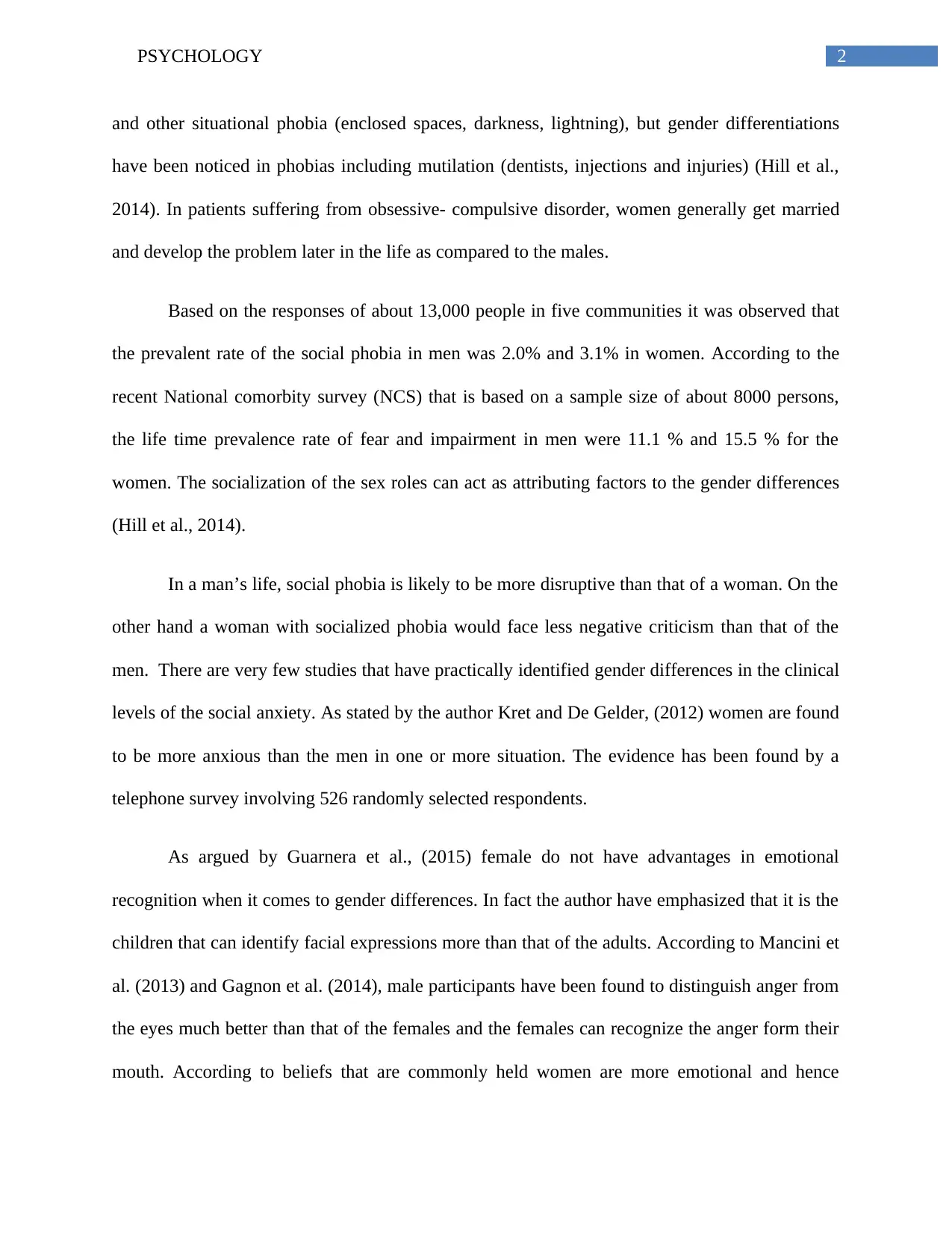
2PSYCHOLOGY
and other situational phobia (enclosed spaces, darkness, lightning), but gender differentiations
have been noticed in phobias including mutilation (dentists, injections and injuries) (Hill et al.,
2014). In patients suffering from obsessive- compulsive disorder, women generally get married
and develop the problem later in the life as compared to the males.
Based on the responses of about 13,000 people in five communities it was observed that
the prevalent rate of the social phobia in men was 2.0% and 3.1% in women. According to the
recent National comorbity survey (NCS) that is based on a sample size of about 8000 persons,
the life time prevalence rate of fear and impairment in men were 11.1 % and 15.5 % for the
women. The socialization of the sex roles can act as attributing factors to the gender differences
(Hill et al., 2014).
In a man’s life, social phobia is likely to be more disruptive than that of a woman. On the
other hand a woman with socialized phobia would face less negative criticism than that of the
men. There are very few studies that have practically identified gender differences in the clinical
levels of the social anxiety. As stated by the author Kret and De Gelder, (2012) women are found
to be more anxious than the men in one or more situation. The evidence has been found by a
telephone survey involving 526 randomly selected respondents.
As argued by Guarnera et al., (2015) female do not have advantages in emotional
recognition when it comes to gender differences. In fact the author have emphasized that it is the
children that can identify facial expressions more than that of the adults. According to Mancini et
al. (2013) and Gagnon et al. (2014), male participants have been found to distinguish anger from
the eyes much better than that of the females and the females can recognize the anger form their
mouth. According to beliefs that are commonly held women are more emotional and hence
and other situational phobia (enclosed spaces, darkness, lightning), but gender differentiations
have been noticed in phobias including mutilation (dentists, injections and injuries) (Hill et al.,
2014). In patients suffering from obsessive- compulsive disorder, women generally get married
and develop the problem later in the life as compared to the males.
Based on the responses of about 13,000 people in five communities it was observed that
the prevalent rate of the social phobia in men was 2.0% and 3.1% in women. According to the
recent National comorbity survey (NCS) that is based on a sample size of about 8000 persons,
the life time prevalence rate of fear and impairment in men were 11.1 % and 15.5 % for the
women. The socialization of the sex roles can act as attributing factors to the gender differences
(Hill et al., 2014).
In a man’s life, social phobia is likely to be more disruptive than that of a woman. On the
other hand a woman with socialized phobia would face less negative criticism than that of the
men. There are very few studies that have practically identified gender differences in the clinical
levels of the social anxiety. As stated by the author Kret and De Gelder, (2012) women are found
to be more anxious than the men in one or more situation. The evidence has been found by a
telephone survey involving 526 randomly selected respondents.
As argued by Guarnera et al., (2015) female do not have advantages in emotional
recognition when it comes to gender differences. In fact the author have emphasized that it is the
children that can identify facial expressions more than that of the adults. According to Mancini et
al. (2013) and Gagnon et al. (2014), male participants have been found to distinguish anger from
the eyes much better than that of the females and the females can recognize the anger form their
mouth. According to beliefs that are commonly held women are more emotional and hence
⊘ This is a preview!⊘
Do you want full access?
Subscribe today to unlock all pages.

Trusted by 1+ million students worldwide
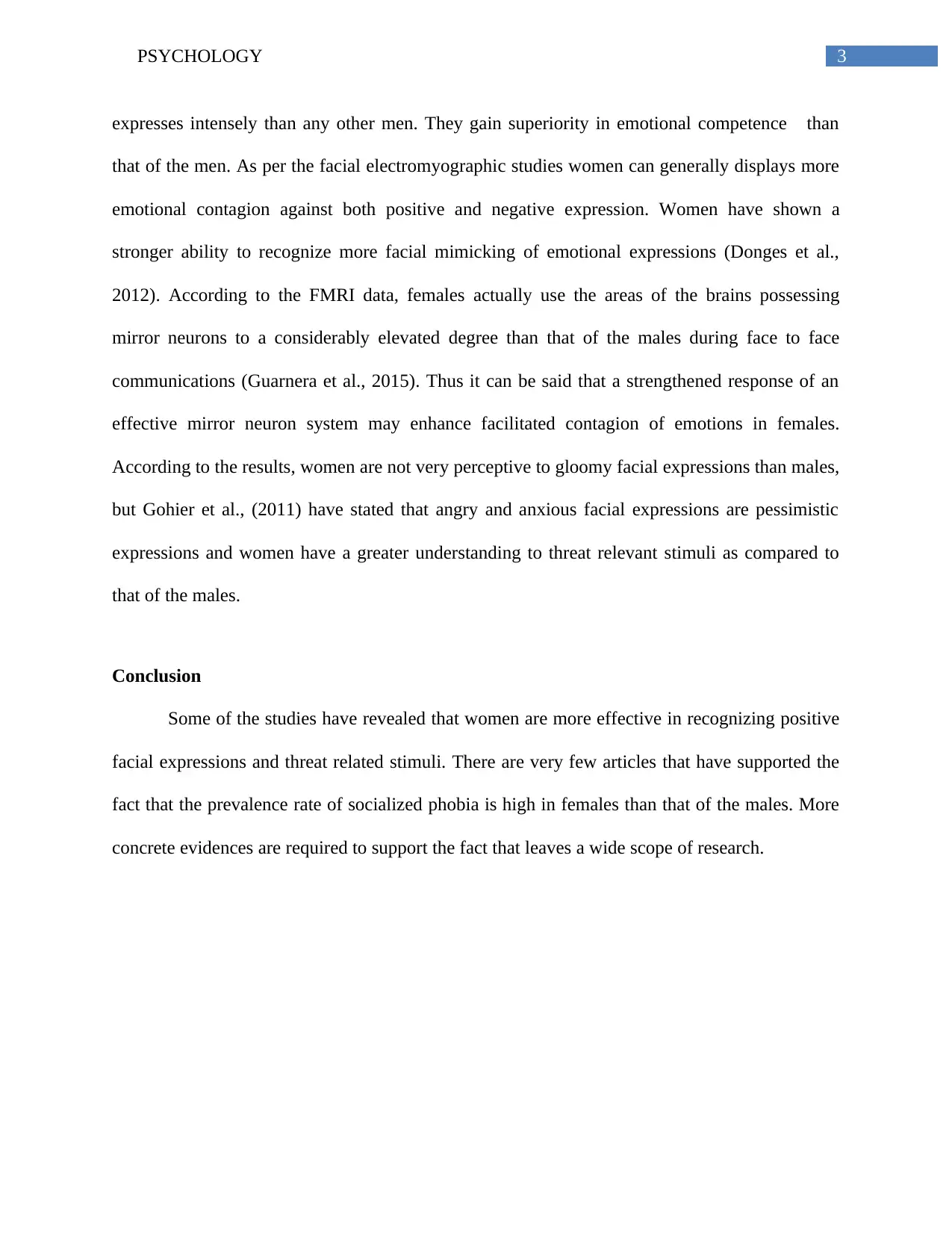
3PSYCHOLOGY
expresses intensely than any other men. They gain superiority in emotional competence than
that of the men. As per the facial electromyographic studies women can generally displays more
emotional contagion against both positive and negative expression. Women have shown a
stronger ability to recognize more facial mimicking of emotional expressions (Donges et al.,
2012). According to the FMRI data, females actually use the areas of the brains possessing
mirror neurons to a considerably elevated degree than that of the males during face to face
communications (Guarnera et al., 2015). Thus it can be said that a strengthened response of an
effective mirror neuron system may enhance facilitated contagion of emotions in females.
According to the results, women are not very perceptive to gloomy facial expressions than males,
but Gohier et al., (2011) have stated that angry and anxious facial expressions are pessimistic
expressions and women have a greater understanding to threat relevant stimuli as compared to
that of the males.
Conclusion
Some of the studies have revealed that women are more effective in recognizing positive
facial expressions and threat related stimuli. There are very few articles that have supported the
fact that the prevalence rate of socialized phobia is high in females than that of the males. More
concrete evidences are required to support the fact that leaves a wide scope of research.
expresses intensely than any other men. They gain superiority in emotional competence than
that of the men. As per the facial electromyographic studies women can generally displays more
emotional contagion against both positive and negative expression. Women have shown a
stronger ability to recognize more facial mimicking of emotional expressions (Donges et al.,
2012). According to the FMRI data, females actually use the areas of the brains possessing
mirror neurons to a considerably elevated degree than that of the males during face to face
communications (Guarnera et al., 2015). Thus it can be said that a strengthened response of an
effective mirror neuron system may enhance facilitated contagion of emotions in females.
According to the results, women are not very perceptive to gloomy facial expressions than males,
but Gohier et al., (2011) have stated that angry and anxious facial expressions are pessimistic
expressions and women have a greater understanding to threat relevant stimuli as compared to
that of the males.
Conclusion
Some of the studies have revealed that women are more effective in recognizing positive
facial expressions and threat related stimuli. There are very few articles that have supported the
fact that the prevalence rate of socialized phobia is high in females than that of the males. More
concrete evidences are required to support the fact that leaves a wide scope of research.
Paraphrase This Document
Need a fresh take? Get an instant paraphrase of this document with our AI Paraphraser
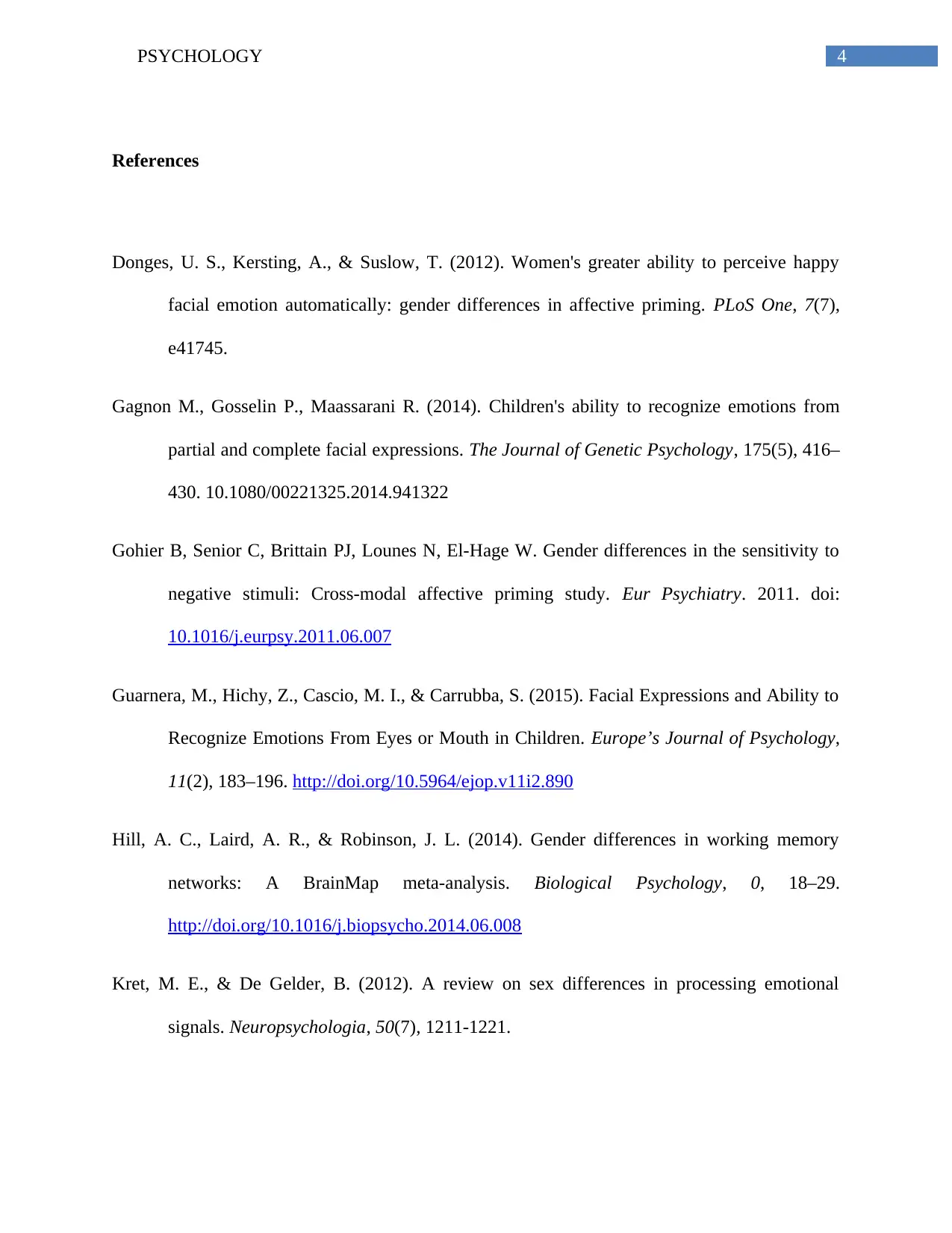
4PSYCHOLOGY
References
Donges, U. S., Kersting, A., & Suslow, T. (2012). Women's greater ability to perceive happy
facial emotion automatically: gender differences in affective priming. PLoS One, 7(7),
e41745.
Gagnon M., Gosselin P., Maassarani R. (2014). Children's ability to recognize emotions from
partial and complete facial expressions. The Journal of Genetic Psychology, 175(5), 416–
430. 10.1080/00221325.2014.941322
Gohier B, Senior C, Brittain PJ, Lounes N, El-Hage W. Gender differences in the sensitivity to
negative stimuli: Cross-modal affective priming study. Eur Psychiatry. 2011. doi:
10.1016/j.eurpsy.2011.06.007
Guarnera, M., Hichy, Z., Cascio, M. I., & Carrubba, S. (2015). Facial Expressions and Ability to
Recognize Emotions From Eyes or Mouth in Children. Europe’s Journal of Psychology,
11(2), 183–196. http://doi.org/10.5964/ejop.v11i2.890
Hill, A. C., Laird, A. R., & Robinson, J. L. (2014). Gender differences in working memory
networks: A BrainMap meta-analysis. Biological Psychology, 0, 18–29.
http://doi.org/10.1016/j.biopsycho.2014.06.008
Kret, M. E., & De Gelder, B. (2012). A review on sex differences in processing emotional
signals. Neuropsychologia, 50(7), 1211-1221.
References
Donges, U. S., Kersting, A., & Suslow, T. (2012). Women's greater ability to perceive happy
facial emotion automatically: gender differences in affective priming. PLoS One, 7(7),
e41745.
Gagnon M., Gosselin P., Maassarani R. (2014). Children's ability to recognize emotions from
partial and complete facial expressions. The Journal of Genetic Psychology, 175(5), 416–
430. 10.1080/00221325.2014.941322
Gohier B, Senior C, Brittain PJ, Lounes N, El-Hage W. Gender differences in the sensitivity to
negative stimuli: Cross-modal affective priming study. Eur Psychiatry. 2011. doi:
10.1016/j.eurpsy.2011.06.007
Guarnera, M., Hichy, Z., Cascio, M. I., & Carrubba, S. (2015). Facial Expressions and Ability to
Recognize Emotions From Eyes or Mouth in Children. Europe’s Journal of Psychology,
11(2), 183–196. http://doi.org/10.5964/ejop.v11i2.890
Hill, A. C., Laird, A. R., & Robinson, J. L. (2014). Gender differences in working memory
networks: A BrainMap meta-analysis. Biological Psychology, 0, 18–29.
http://doi.org/10.1016/j.biopsycho.2014.06.008
Kret, M. E., & De Gelder, B. (2012). A review on sex differences in processing emotional
signals. Neuropsychologia, 50(7), 1211-1221.
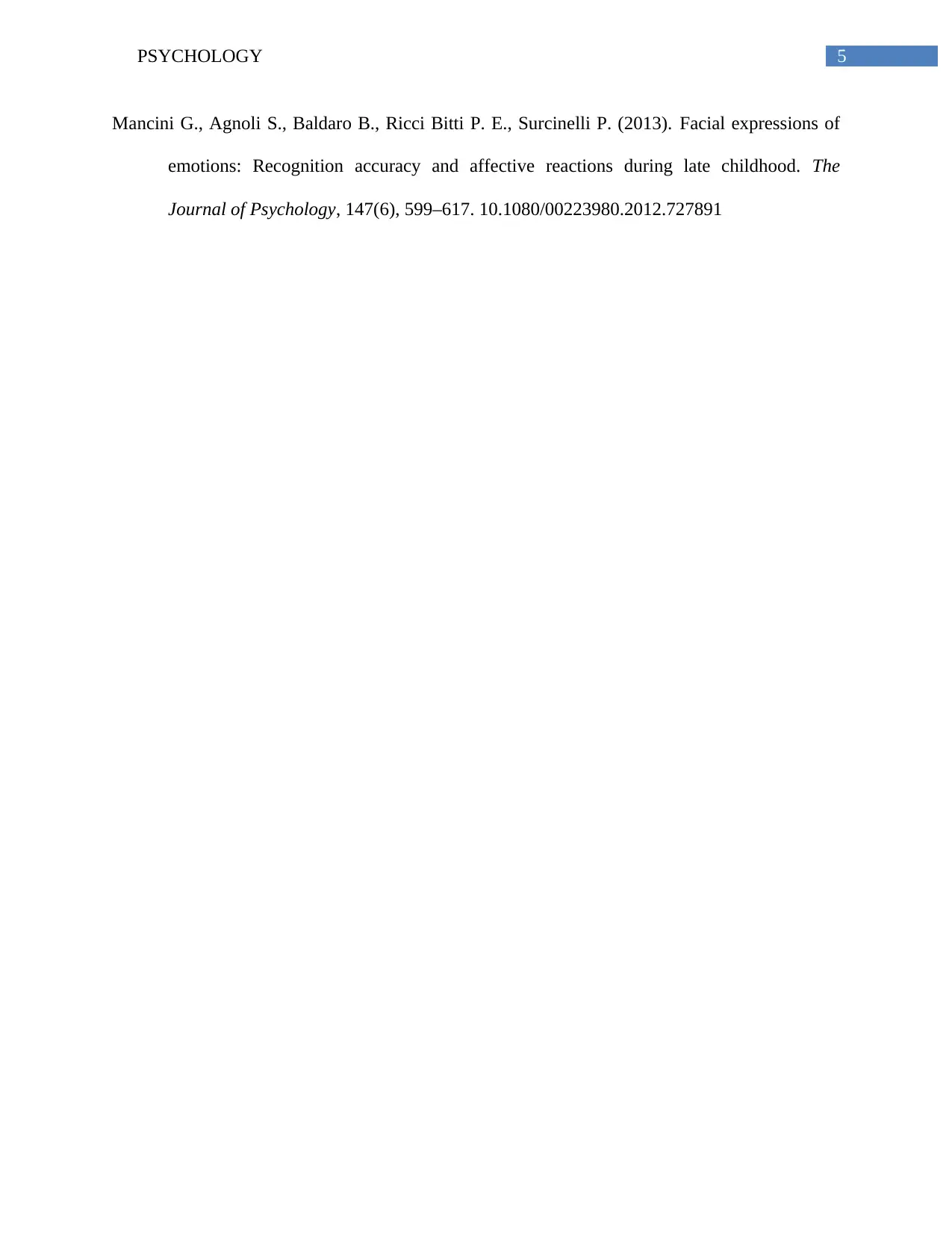
5PSYCHOLOGY
Mancini G., Agnoli S., Baldaro B., Ricci Bitti P. E., Surcinelli P. (2013). Facial expressions of
emotions: Recognition accuracy and affective reactions during late childhood. The
Journal of Psychology, 147(6), 599–617. 10.1080/00223980.2012.727891
Mancini G., Agnoli S., Baldaro B., Ricci Bitti P. E., Surcinelli P. (2013). Facial expressions of
emotions: Recognition accuracy and affective reactions during late childhood. The
Journal of Psychology, 147(6), 599–617. 10.1080/00223980.2012.727891
⊘ This is a preview!⊘
Do you want full access?
Subscribe today to unlock all pages.

Trusted by 1+ million students worldwide
1 out of 6
Related Documents
Your All-in-One AI-Powered Toolkit for Academic Success.
+13062052269
info@desklib.com
Available 24*7 on WhatsApp / Email
![[object Object]](/_next/static/media/star-bottom.7253800d.svg)
Unlock your academic potential
Copyright © 2020–2025 A2Z Services. All Rights Reserved. Developed and managed by ZUCOL.





